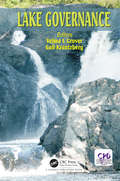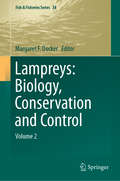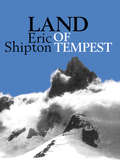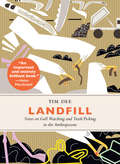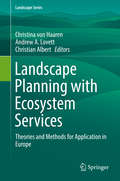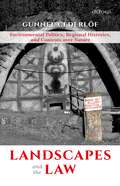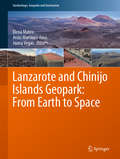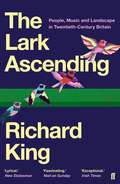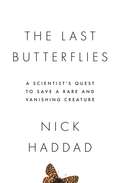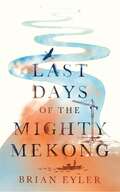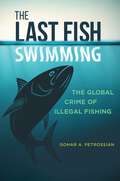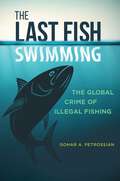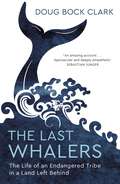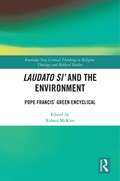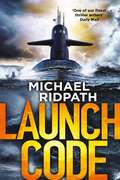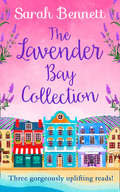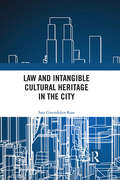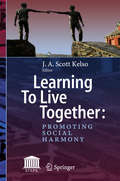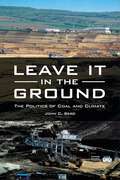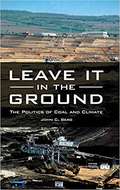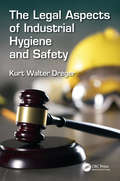- Table View
- List View
Lake Governance
by Velma I. Grover Gail KrantzbergThe Lake Governance book will focus on comparative analysis of governance structures by examining policy, legal and institutional structures of current transboundary commissions to develop a common framework for good governance of transboundary lakes. Cooperation among nations sharing natural resources is important for sustainable use of the shared resources. Lakes contribute a big part to GDP in most of the countries and in some cases are also responsible for providing fisheries (for food, source of protein and livelihood). Climate change and associated risks and uncertainties add more complexity to the problems. This book will explore current water governance challenges, knowledge gaps and recommend a framework for good lake governance.
Lake Governance: Lessons In Participatory Governance
by Velma I. Grover Gail KrantzbergThe Lake Governance book will focus on comparative analysis of governance structures by examining policy, legal and institutional structures of current transboundary commissions to develop a common framework for good governance of transboundary lakes. Cooperation among nations sharing natural resources is important for sustainable use of the shared resources. Lakes contribute a big part to GDP in most of the countries and in some cases are also responsible for providing fisheries (for food, source of protein and livelihood). Climate change and associated risks and uncertainties add more complexity to the problems. This book will explore current water governance challenges, knowledge gaps and recommend a framework for good lake governance.
Lampreys: Volume 2 (Fish & Fisheries Series #38)
by Margaret F. DockerThis book, published in two volumes, provides the most comprehensive review of lamprey biology since Hardisty and Potter’s “The Biology of Lampreys” published more than 30 years ago. This second volume offers a synthesis of topics related to the lamprey gonad (e.g., lamprey sex ratios, sex determination and sex differentiation, sexual maturation, and sex steroids), the artifical propagation of lampreys, post-metamorphic feeding and the evolution of alternative feeding and migratory types, the history and status of sea lamprey control in the Laurentian Great Lakes and Lake Champlain, and an overview of contributions of lamprey developmental studies for understanding vertebrate evolution.
Land of Tempest: Travels in Patagonia: 1958-1962
by Eric ShiptonLand of Tempest reveals Shipton at his best - writing with enthusiasm and humour about his explorations in Patagonia in the 1950s and 1960s. He is an astute observer of nature and the human spirit, and this account of his travels is infused with with his own zest for discovery and the joy of camaraderie. Undaunted by hardship or by injury, Shipton and his team attempt to cross one of the great ice-caps in Patagonia. It’s impossible not to marvel at his determination, resilience and appetite for travel and adventure, be it climbing snow-clad mountains, or walking in forested foothills. Shipton takes a reader with him on his travels, and the often-inhospitable places he visits are a stark contrast to the warmth of the people he encounters. Land of Tempest is essential reading for anyone who loves nature, mountains, climbing, adventure or simply the joy of discovering unknown places.
Landfill: Notes on Gull Watching and Trash Picking in the Anthropocene
by Tim DeeOver the past hundred years, gulls have been brought ashore by modernity. They now live not only on the coasts but in our slipstream following trawlers, barges, and garbage trucks. They are more our contemporaries than most birds, living their wild lives among us in towns and cities. In many ways they live as we do, walking the built-up world and grabbing a bite where they can. Yet this disturbs us. We’ve started fearing gulls for getting good at being among us. We see them as scavengers, not entrepreneurs; ocean-going aliens, not refugees. They are too big for the world they have entered. Their story is our story too. Landfill is the original and compelling story of how in the Anthropocene we have learned about the natural world, named and catalogued it, and then colonized it, planted it, or filled it with our junk. While most other birds have gone in the opposite direction, hiding away from us, some vanishing forever, gulls continue to tell us how the wild can share our world. For these reasons Landfill is the nature book for our times, groundbreaking and genre-bending. Without nostalgia or eulogy, it kicks beneath the littered surface of the things to discover stranger truths.
Landscape Planning with Ecosystem Services: Theories and Methods for Application in Europe (Landscape Series #24)
by Christina Von Haaren Andrew A. Lovett Christian AlbertHuman well-being depends in many ways on maintaining the stock of natural resources which deliver the services from which human’s benefit. However, these resources and flows of services are increasingly threatened by unsustainable and competing land uses. Particular threats exist to those public goods whose values are not well-represented in markets or whose deterioration will only affect future generations. As market forces alone are not sufficient, effective means for local and regional planning are needed in order to safeguard scarce natural resources, coordinate land uses and create sustainable landscape structures. This book argues that a solution to such challenges in Europe can be found by merging the landscape planning tradition with ecosystem services concepts. Landscape planning has strengths in recognition of public benefits and implementation mechanisms, while the ecosystem services approach makes the connection between the status of natural assets and human well-being more explicit. It can also provide an economic perspective, focused on individual preferences and benefits, which helps validate the acceptability of environmental planning goals. Thus linking landscape planning and ecosystem services provides a two-way benefit, creating a usable science to meet the needs of local and regional decision making. The book is structured around the Driving forces-Pressures-States-Impacts-Responses framework, providing an introduction to relevant concepts, methodologies and techniques. It presents a new, ecosystem services-informed, approach to landscape planning that constitutes both a framework and toolbox for students and practitioners to address the environmental and landscape challenges of 21st century Europe.
Landscapes and the Law: Environmental Politics, Regional Histories, and Contests over Nature
by Gunnel CederlöfLandscapes and the Law is situated at the crossroads of environmental, colonial, and legal history. It examines the role of law in consolidating early colonial rule from the perspective of people’s access to nature in forests and hill tracts. This major interdisciplinary study is thus concerned with the social history of legal processes and the making of law, being as relevant today as it was when first published a decade ago. The book is focused equally on the multitude of colliding claims for access to land and resources, and the complex ways in which customary rights are redefined and codified for the purpose of securing and legitimizing colonial sovereign rule. Basing her archival and field work on the Nilgiri Hills in South India, Gunnel Cederlöf explores conflicting perceptions of nature and political visions that are projected onto landscapes and people. She traces debates on property and land rights, and how the empirical sciences merge with the legal claims justifying land acquisition. Popular resistance strategies to such exploitation are analysed, and a cross-cultural comparison made between early legal processes and social history in India, New Zealand, and North America.
Lanzarote and Chinijo Islands Geopark: From Earth to Space (Geoheritage, Geoparks and Geotourism)
by Elena Mateo Jesús Martínez-Frías Juana VegasThis volume comprises a selection of papers describing the main features of the Lanzarote and Chinijo Islands Geopark (Canary Archipelago, Spain). Of all the Global Geoparks worldwide, it is the only one that has officially evaluated and characterized specific areas as analogues for the geological and astrobiological exploration of Mars. The identification and characterization of terrestrial sites that can be used as planetary analogues are currently considered vital study areas of planetary geology and astrobiology. Written by experts in the various fields, this multidisciplinary book is a unique resource for graduate students and professionals alike.
The Lark Ascending: The Music of the British Landscape
by Richard KingOriginally from Newport, Gwent, for the last eighteen years Richard King has lived in the hill farming country of Radnosrshire, Powys. He is the author of Original Rockers, which was shortlisted for the Gordon Burn Prize, and How Soon Is Now?, both published by Faber.
The Last Butterflies: A Scientist's Quest to Save a Rare and Vanishing Creature
by Nick HaddadA remarkable look at the rarest butterflies, how global changes threaten their existence, and how we can bring them back from near-extinctionMost of us have heard of such popular butterflies as the Monarch or Painted Lady. But what about the Fender’s Blue? Or the St. Francis’ Satyr? Because of their extreme rarity, these butterflies are not well-known, yet they are remarkable species with important lessons to teach us. The Last Butterflies spotlights the rarest of these creatures—some numbering no more than what can be held in one hand. Drawing from his own first-hand experiences, Nick Haddad explores the challenges of tracking these vanishing butterflies, why they are disappearing, and why they are worth saving. He also provides startling insights into the effects of human activity and environmental change on the planet’s biodiversity.Weaving a vivid and personal narrative with ideas from ecology and conservation, Haddad illustrates the race against time to reverse the decline of six butterfly species. Many scientists mistakenly assume we fully understand butterflies’ natural histories. Yet, as with the Large Blue in England, we too often know too little and the conservation consequences are dire. Haddad argues that a hands-off approach is not effective and that in many instances, like for the Fender’s Blue and Bay Checkerspot, active and aggressive management is necessary. With deliberate conservation, rare butterflies can coexist with people, inhabit urban fringes, and, in the case of the St. Francis’ Satyr, even reside on bomb ranges and military land. Haddad shows that through the efforts to protect and restore butterflies, we might learn how to successfully confront conservation issues for all animals and plants.A moving account of extinction, recovery, and hope, The Last Butterflies demonstrates the great value of these beautiful insects to science, conservation, and people.
Last Days of the Mighty Mekong (Asian Arguments)
by Brian EylerCelebrated for its natural beauty and its abundance of wildlife, the Mekong river runs thousands of miles through China, Myanmar, Laos, Thailand, Cambodia, and Vietnam. Its basin is home to more than 70 million people and has for centuries been one of the world's richest agricultural areas and a biodynamic wonder. Today, however, it is undergoing profound changes. Development policies, led by a rising China in particular, aim to interconnect the region and urbanize the inhabitants. And a series of dams will harness the river's energy, while also stymieing its natural cycles and cutting off food supplies for swathes of the population. In Last Days of the Mighty Mekong, Brian Eyler travels from the river's headwaters in China to its delta in southern Vietnam to explore its modern evolution. Along the way he meets the region's diverse peoples, from villagers to community leaders, politicians to policy makers. Through conversations with them he reveals the urgent struggle to save the Mekong and its unique ecosystem.
The Last Fish Swimming: The Global Crime of Illegal Fishing (Global Crime and Justice)
by Gohar A. PetrossianThis book examines the global, local, and specific environmental factors that facilitate illegal fishing and proposes effective ways to reduce the opportunities and incentives that threaten the existence of the world's fish.Humans are deeply dependent on fishing—globally, fish comprise 15 percent of the protein intake for approximately 3 billion people, and 8 percent of the global population depends on the fishing industry as their livelihood. The global fishing industry is plagued by illegal fishing, however, and many highly commercial species, such as cod, tuna, orange roughy, and swordfish, are extremely vulnerable. Through criminological analysis, The Last Fish Swimming emphasizes the importance of looking at specific environmental factors that make illegal fishing possible. It examines such factors as proximity to known ports where illegally caught fish can be landed without inspection (i.e., ports of convenience), fisheries monitoring, control and surveillance efforts, formal surveillance, and resource attractiveness in 53 countries that altogether represent 96 percent of the world's fish catch. The book calls upon the global community to address the illegal depletion of the world's fish stock and other similar threats to the world's food supply and natural environment in order to ensure the sustainability of the planet's fish and continuation of the legal fishing industry for generations to come.
The Last Fish Swimming: The Global Crime of Illegal Fishing (Global Crime and Justice)
by Gohar A. PetrossianThis book examines the global, local, and specific environmental factors that facilitate illegal fishing and proposes effective ways to reduce the opportunities and incentives that threaten the existence of the world's fish.Humans are deeply dependent on fishing—globally, fish comprise 15 percent of the protein intake for approximately 3 billion people, and 8 percent of the global population depends on the fishing industry as their livelihood. The global fishing industry is plagued by illegal fishing, however, and many highly commercial species, such as cod, tuna, orange roughy, and swordfish, are extremely vulnerable. Through criminological analysis, The Last Fish Swimming emphasizes the importance of looking at specific environmental factors that make illegal fishing possible. It examines such factors as proximity to known ports where illegally caught fish can be landed without inspection (i.e., ports of convenience), fisheries monitoring, control and surveillance efforts, formal surveillance, and resource attractiveness in 53 countries that altogether represent 96 percent of the world's fish catch. The book calls upon the global community to address the illegal depletion of the world's fish stock and other similar threats to the world's food supply and natural environment in order to ensure the sustainability of the planet's fish and continuation of the legal fishing industry for generations to come.
The Last Whalers: The Life of an Endangered Tribe in a Land Left Behind
by Doug Bock Clark'I absolutely loved this magnificent book' Sebastian Junger'A monumental achievement' Mitchell Zuckoff'[An] immersive, densely reported and altogether remarkable first book ... The Last Whalers has the texture and colouring of a first-rate novel' New York TimesAt a time when global change has eradicated thousands of unique cultures, The Last Whalers tells the stunning inside story of the Lamalerans, an ancient tribe of 1,500 hunter-gatherers who live on a volcanic island so remote it is known by other Indonesians as "The Land Left Behind." They have survived for centuries by taking whales with bamboo harpoons, but now are being pushed toward collapse by the encroachment of the modern world.Award-winning journalist Doug Bock Clark, who lived with the Lamalerans across three years, weaves together their stories with novelistic flair to usher us inside this hidden drama. Jon, an orphaned apprentice whaler, strives to earn his harpoon and feed his ailing grandparents. Ika, Jon's indomitable younger sister, struggles to forge a modern life in a tradition-bound culture and realize a star-crossed love. Ignatius, a legendary harpooner entering retirement, labors to hand down the Ways of the Ancestors to his son, Ben, who would rather become a DJ in the distant tourist mecca of Bali.With brilliant, breathtaking prose and empathetic, fast-paced storytelling, Clark details how the fragile dreams of one of the world's dwindling indigenous peoples are colliding with the irresistible upheavals of our rapidly transforming world, and delivers to us a group of families we will never forget.
Laudato Si’ and the Environment: Pope Francis’ Green Encyclical (Routledge New Critical Thinking in Religion, Theology and Biblical Studies)
by Robert McKimThis volume is a response to Pope Francis’ environmental encyclical Laudato Si’. Published in 2015, the encyclical urges us to face up to the crisis of climate change and to take better care of the Earth, our common home, while also attending to the plight of the poor. In this book the Pope’s invitation to all people to begin a new dialogue about these matters is considered from a variety of perspectives by an international and multidisciplinary team of leading scholars. There is discussion of the implications of Laudato Si’ for immigration, population control, eating animals, and property ownership. Additionally, indigenous religious perspectives, development and environmental protection, and the implementation of the ideas of the encyclical within the Church are explored. Some chapters deal with scriptural or philosophical aspects of the encyclical. Others focus on central concepts, such as interconnectedness, the role of practice, and what Pope Francis calls the "technocratic paradigm." This book expertly illuminates the relationship between Laudato Si’ and environmental concerns. It will be of deep interest to anyone studying religion and the environment, environmental ethics, Catholic theology, or environmental thought.
Laudato Si’ and the Environment: Pope Francis’ Green Encyclical (Routledge New Critical Thinking in Religion, Theology and Biblical Studies)
by Robert McKimThis volume is a response to Pope Francis’ environmental encyclical Laudato Si’. Published in 2015, the encyclical urges us to face up to the crisis of climate change and to take better care of the Earth, our common home, while also attending to the plight of the poor. In this book the Pope’s invitation to all people to begin a new dialogue about these matters is considered from a variety of perspectives by an international and multidisciplinary team of leading scholars. There is discussion of the implications of Laudato Si’ for immigration, population control, eating animals, and property ownership. Additionally, indigenous religious perspectives, development and environmental protection, and the implementation of the ideas of the encyclical within the Church are explored. Some chapters deal with scriptural or philosophical aspects of the encyclical. Others focus on central concepts, such as interconnectedness, the role of practice, and what Pope Francis calls the "technocratic paradigm." This book expertly illuminates the relationship between Laudato Si’ and environmental concerns. It will be of deep interest to anyone studying religion and the environment, environmental ethics, Catholic theology, or environmental thought.
Launch Code: Perfect for fans of Mark Dawson and Mark Billingham
by Michael Ridpath'Hugely enjoyable and thought-provoking, Launch Code brings to mind the classic thrillers of Alister Maclean and Jack Higgins. A well-crafted ingenious mystery, tightly plotted, compelling and contemporary, this could well be Michael Ridpath's best novel yet.' - Stav Sherez, author of the Carrigan & Miller series1983: Three hundred feet beneath the Atlantic, submarine Lieutenant Bill Guth receives the order he's been dreading: a full nuclear strike against the USSR. Crisis is soon averted, but in the chaos that follows, one crew member ends up dead...2019: Bill's annual family gathering is interrupted when a historian turns up, eager to uncover the truth about the near-apocalyptic Cold War incident. Bill refuses to answer, but that night the man is brutally murdered.What happened all those years ago? How much is Bill to blame for events in the past? And who will stop at nothing to keep the secrets of 1983 where they belong?'Deadly state secrets and deadlier family secrets - perfectly crafted, scrupulously researched Launch Code weaves an ingeniously dark and tangled web that will keep you gripped and guessing to the very end. Ridpath is one of the best thriller writers around.' - Craig Russell, author of The Devil Aspect
The Lavender Bay Collection: Including Spring At Lavender Bay, Summer At Lavender Bay And Snowflakes At Lavender Bay
by Sarah Bennett‘Delightfully romantic and touching.’ Phillipa Ashley on Sunrise at Butterfly Cove Could love be just around the corner?
Law and Intangible Cultural Heritage in the City
by Sara Gwendolyn RossWith disappearing music venues, and arts and culture communities at constant risk of displacement in our urban centers, the preservation of intangible cultural heritage is of growing concern to global cities. This book addresses the role and protection of intangible cultural heritage in the urban context. Using the methodology of Urban Legal Anthropology, the author provides an ethnographic account of the civic effort of Toronto to become a Music City from 2014-18 in the context of redevelopment and gentrification pressures. Through this, the book elucidates the problems cities like Toronto have in equitably protecting intangible cultural heritage and what can be done to address this. It also evaluates the engagement that Toronto and other cities have had with international legal frameworks intended to protect intangible cultural heritage, as well as potential counterhegemonic uses of hegemonic legal tools. Understanding urban intangible cultural heritage and the communities of people who produce it is of importance to a range of actors, from urban developers looking to formulate livable and sustainable neighbourhoods, to city leaders looking for ways in which their city can flourish, to scholars and individuals concerned with equitability and the right to the city. This book is the beginning of a conservation about what is important for us to protect in the city for future generations beyond built structures, and the role of intangible cultural heritage in the creation of full and happy lives. The book is of interest to legal and sociolegal readers, specifically those who study cities, cultural heritage law, and legal anthropology.
Law and Intangible Cultural Heritage in the City
by Sara Gwendolyn RossWith disappearing music venues, and arts and culture communities at constant risk of displacement in our urban centers, the preservation of intangible cultural heritage is of growing concern to global cities. This book addresses the role and protection of intangible cultural heritage in the urban context. Using the methodology of Urban Legal Anthropology, the author provides an ethnographic account of the civic effort of Toronto to become a Music City from 2014-18 in the context of redevelopment and gentrification pressures. Through this, the book elucidates the problems cities like Toronto have in equitably protecting intangible cultural heritage and what can be done to address this. It also evaluates the engagement that Toronto and other cities have had with international legal frameworks intended to protect intangible cultural heritage, as well as potential counterhegemonic uses of hegemonic legal tools. Understanding urban intangible cultural heritage and the communities of people who produce it is of importance to a range of actors, from urban developers looking to formulate livable and sustainable neighbourhoods, to city leaders looking for ways in which their city can flourish, to scholars and individuals concerned with equitability and the right to the city. This book is the beginning of a conservation about what is important for us to protect in the city for future generations beyond built structures, and the role of intangible cultural heritage in the creation of full and happy lives. The book is of interest to legal and sociolegal readers, specifically those who study cities, cultural heritage law, and legal anthropology.
Leadership for the North: The Influence and Impact of Arctic Council Chairs (Springer Polar Sciences)
by Douglas C. NordThis book investigates multidimensional change in the Arctic and policy response to it. It focuses its attention on the need for effective leadership within the region. In so doing it considers the contribution made by the main international organization of the region, the Arctic Council. In particular, it examines the various leadership functions undertaken by the Chair of that body including that of convener, manager, promoter, representative and resolver of differences. It is argued that in performing these multiple roles the Chair is contributing to the necessary leadership required to address pressing Arctic concerns. The book highlights the activities of the four most recent Arctic Council Chairs, Sweden, Canada, the United States and Finland. It considers the programs for action that each of these countries promoted during their terms at the helm of this major circumpolar organization. It examines the particular approaches, methods and strategies that each used to advance its agenda and the consequences of such efforts. It focuses attention on the need for building consensus among a diverse membership including Arctic states, organizations representing northern indigenous peoples, non-Arctic countries and non-governmental bodies. Drawing upon the insights of scholars from several disciplines from across the circumpolar community, the collected essays in this volume seek to paint a picture of the real challenges and opportunities for international diplomacy in the contemporary North. It suggests that there are true “lessons to be learned” in advancing leadership within the region. The book provides a means for considering these and the most effective means of response.
Learning To Live Together: Promoting Social Harmony
by J. A. KelsoThis book is devoted to the issue of how we can learn to live together in the face of division and conflict. It is dedicated to the life and work of a remarkable human being, Dr Epimenidis Haidemenakis, scientist, statesman, visionary leader, President Emeritus of the International S.T.E.P.S. Foundation and founding father of The Olympiads of the Mind (OM). The monograph consists of a collection of papers presented at the 8th and 9th Olympiads of the Mind held in Washington, DC and Chania, Crete respectively. Distinguished international scholars, government and corporate representatives, leading researchers and academics from multiple disciplines and Nobel Laureates Leon Lederman (Physics, 1988), Martin Perl (Physics, 1995) and Yuan T. Lee (Chemistry, 1986) address a broad range of issues all with the aim of improving the human condition and achieving cooperation among the people of the world. The topics include the environment, sustainability and security; diversity and how to achieve integration and peace among people in a fractured world; the important role of brain research; how to overcome poverty and inequality; how to enhance creativity and improve education at all levels; and how new technologies and tools can be used for common benefit. The culmination of the book is a call to action, to join what one might call the “OM Movement”—bringing the best minds in the world together to create solutions to world issues so that we can all live together in harmony.
Leave It in the Ground: The Politics of Coal and Climate
by John C. BergEmploying scientific explanations and hard data, this book shows why coal is such a problem, how the pro-coal forces got to be so powerful, and how those forces might be defeated through political activism.Coal provided the energy to build modern civilization. This energy source raised standards of living, multiplied the earth's population, and enabled people in developed countries to enjoy leisure time. Today, we know that if we burn all the coal available, climate change will continue to increase. But the use of coal isn't purely an environmental issue; there are also political and economic forces at play. This book examines the politics and environmental impact of coal production and distribution, presenting a clear point of view—that we must shift away from coal use—backed by hard data and supplying specific prescriptions for opposing and regulating the coal industry.Author John C. Berg explains how ending the burning of coal (and of oil and natural gas) is a political problem rather than a technical one; explodes the "clean coal" myth, providing scientific documentation of how burning coal emits more greenhouse gases per unit of energy than any other fuel; and describes how controlling coal use in the United States will also serve to restore the possibility of a meaningful international climate agreement. Additionally, readers will understand the critical importance of activism—from local to international—in spurring government regulation to control the coal industry, which can only be defeated politically.
Leave It in the Ground: The Politics of Coal and Climate
by John C. BergEmploying scientific explanations and hard data, this book shows why coal is such a problem, how the pro-coal forces got to be so powerful, and how those forces might be defeated through political activism.Coal provided the energy to build modern civilization. This energy source raised standards of living, multiplied the earth's population, and enabled people in developed countries to enjoy leisure time. Today, we know that if we burn all the coal available, climate change will continue to increase. But the use of coal isn't purely an environmental issue; there are also political and economic forces at play. This book examines the politics and environmental impact of coal production and distribution, presenting a clear point of view—that we must shift away from coal use—backed by hard data and supplying specific prescriptions for opposing and regulating the coal industry.Author John C. Berg explains how ending the burning of coal (and of oil and natural gas) is a political problem rather than a technical one; explodes the "clean coal" myth, providing scientific documentation of how burning coal emits more greenhouse gases per unit of energy than any other fuel; and describes how controlling coal use in the United States will also serve to restore the possibility of a meaningful international climate agreement. Additionally, readers will understand the critical importance of activism—from local to international—in spurring government regulation to control the coal industry, which can only be defeated politically.
The Legal Aspects of Industrial Hygiene and Safety (Sustainable Improvements in Environment Safety and Health)
by Kurt W. DregerThe Legal Aspects of Industrial Hygiene and Safety explores various legal issues that are often encountered by Industrial Hygiene and Safety managers during their careers. A description is presented of the various legal concepts and processes that often arise in the IH/S practice, including tort, contract, and administrative law. The goal is to provide IH/S managers with sufficient knowledge to be able to incorporate legal risk analysis into everyday decision-making and policy development. This book will explore the legal issues that arise in IH/S practice and will be helpful to new IH/S managers as they progress in their careers. FEATURES Explores various legal issues that are often encountered by Industrial Hygiene and Safety managers during their careers Provides insight into the legal issues and processes to IH/S managers that are traditionally only available to attorneys Improves the IH/S managers' ability to communicate complex IH/S issues to in-house counsel Presents tools and knowledge to IH/S managers so they can better consider the legal risks of the decisions they make Covers various legal concepts and processes that can arise in the IH/S practice, including tort, contract, and administrative law
